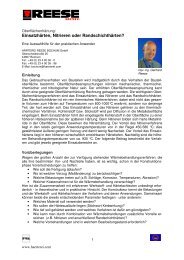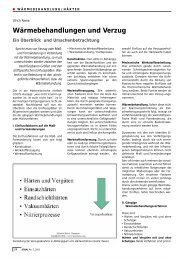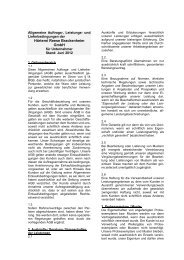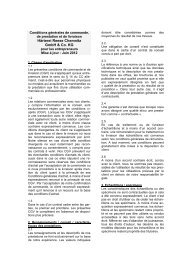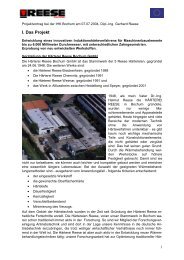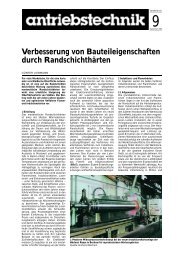GTC (June 2011) - Härterei Reese Bochum GmbH
GTC (June 2011) - Härterei Reese Bochum GmbH
GTC (June 2011) - Härterei Reese Bochum GmbH
Create successful ePaper yourself
Turn your PDF publications into a flip-book with our unique Google optimized e-Paper software.
4. Formation and content of the contract /<br />
Guarantee / Acceptance<br />
4.1<br />
Our quotes are non-binding unless they are<br />
expressly described as binding or contain<br />
binding commitments. They are invitations to<br />
treat. A contract does not come into existence<br />
- even in the case of ongoing business -<br />
until we confirm the customer’s order in writing<br />
or text form (i.e. including by fax or email).<br />
In the case of immediate delivery, our<br />
confirmation can be replaced by our invoice.<br />
4.2<br />
The content of the contract is dependent on<br />
our order confirmation.<br />
4.3<br />
The required heat treatment is carried out<br />
once the order has been placed in accordance<br />
with the provisions of 4.7 as a service<br />
with the necessary care and using appropriate<br />
means. A specific result of heat treatment,<br />
e.g. in the form of the absence of deformities<br />
and cracks, surface hardness,<br />
hardness penetration, continuous hardening,<br />
galvanisability and the like, is not guaranteed<br />
because of potential differences in the hardenability<br />
of the material used, hidden defects,<br />
unfavourable shaping or any changes<br />
which may have occurred in the preceding<br />
stage of the work.<br />
4.4<br />
All agreements, side agreements, warranties<br />
and changes to the contract must be in writing.<br />
This also applies to the removal of the<br />
requirement for the written form itself. Verbal<br />
changes or additions to the contract are not<br />
valid. The precedence of an individual<br />
agreement (Art. 305 b BGB) remains unchanged.<br />
4.5<br />
In the case of call-off orders or delays in acceptance<br />
for reasons attributable to the customer,<br />
we are entitled to manufacture the<br />
whole order quantity/carry out all the work to<br />
which the order relates immediately. Therefore<br />
any changes required by the customer<br />
can no longer be taken into account once the<br />
order has been placed, unless specifically<br />
agreed in writing.<br />
4.6<br />
The customer shall notify us in writing in<br />
good time prior to entering into the contract of<br />
Page 2<br />
any special requirements with regard to our<br />
products.<br />
4.7<br />
All workpieces which are handed over for<br />
heat treatment must be accompanied by an<br />
order or a delivery note containing the following<br />
information:<br />
a) description, number of units, net weight,<br />
value of the parts and nature of the packaging;<br />
b) material quality (standard designation and<br />
steel grade and steel manufacturer);<br />
c) the desired heat treatment, particularly:<br />
aa) in the case of carburising steels pursuant<br />
to DIN 6773, either the required carburisation<br />
depth with carbon content limit (e.g. carburisation<br />
depth 0.35 = 0.8 + 0.4 mm) or the<br />
prescribed carburisation hardening depth<br />
with reference hardness value and surface<br />
hardness (e.g. carburisation hardening depth<br />
550 HV1 = 0.2 – 0.4 mm, surface hardness =<br />
at least 700 HV5);<br />
bb) in the case of heat-treated steels, the<br />
required tensile strength. The Brinell ball<br />
impression test at the surface shall be conclusive<br />
for the purpose of ascertaining the<br />
tensile strength, unless otherwise agreed;<br />
cc) in the case of steels for tools and highspeed<br />
steels, the desired level of hardness<br />
according to Rockwell or Vickers;<br />
dd) in the case of nitriding steels, the desired<br />
nitriding hardness depth;<br />
ee) in the case of induction hardening and<br />
flame hardening, the desired surface hardness<br />
depth, with reference hardness value<br />
and surface hardness and the position of the<br />
region to be hardened;<br />
ff) in the case of salt bath nitrocarburising<br />
and gas-short-time-nitriding, either the duration<br />
of the treatment or the desired strength<br />
of the joining zone;<br />
d) details of the desired test procedure, the<br />
test facility and the test load (see DIN test<br />
standards);<br />
e) any additional information or requirements<br />
necessary for the success of the treatment<br />
(see DIN 6773, DIN EN 10 052, DIN 17021,<br />
DIN 17023). When partial hardening is required,<br />
drawings must be attached showing<br />
which areas must become hard and which<br />
must remain soft. If similar workpieces are<br />
produced from different molten steels, this<br />
must be stated. Likewise, any particular requirements<br />
relating to dimensional accuracy<br />
or the surface condition must be noted on the<br />
delivery documents. The customer must in<br />
particular point out any welded or soldered





